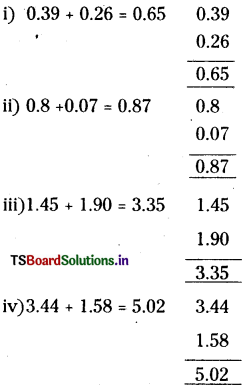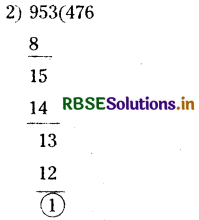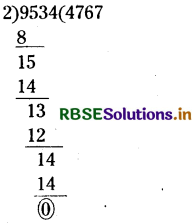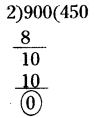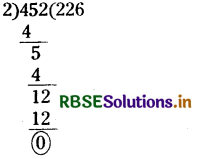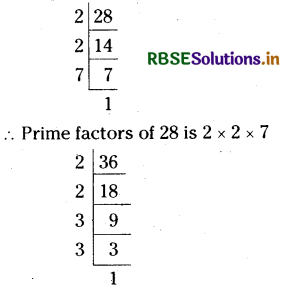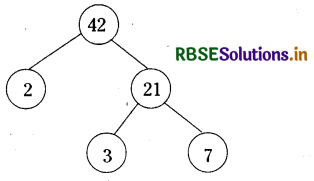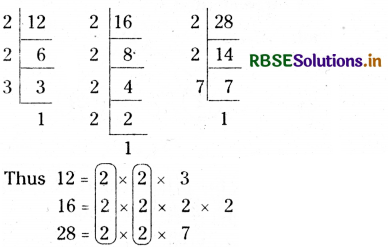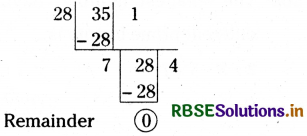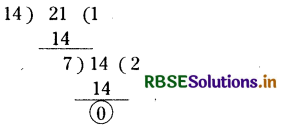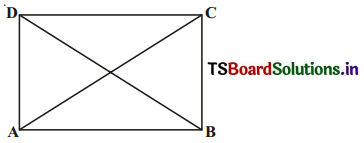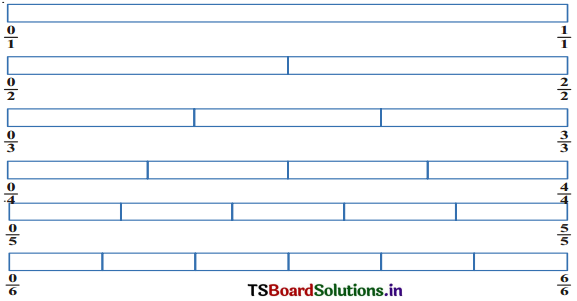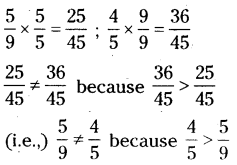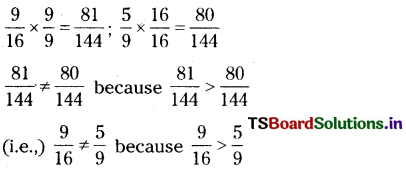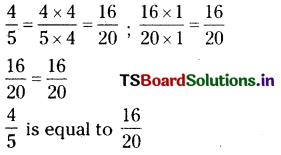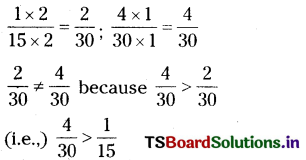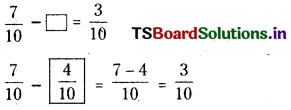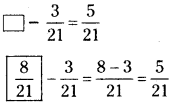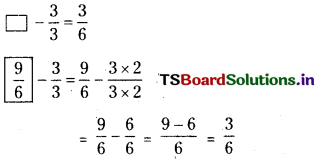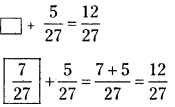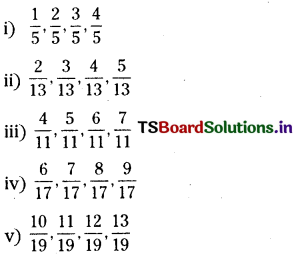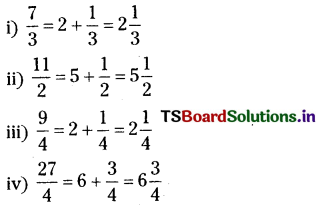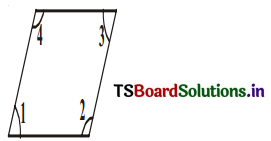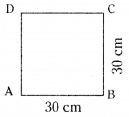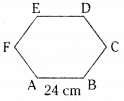Students can practice Telangana 6th Class Maths Textbook Solutions Chapter 7 Fractions and Decimals InText Questions to get the best methods of solving problems.
TS 6th Class Maths Solutions Chapter 7 Fractions and Decimals InText Questions
Try These
Question 1.
How will you represent the following pictorially ?
(i) \(\frac{3}{4}\)
Answer:
\(\frac{3}{4}\)

(ii) \(\frac{2}{8}\)
Answer:
\(\frac{2}{8}\)
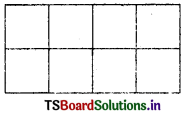
(iii) \(\frac{1}{3}\)
Answer:
\(\frac{1}{3}\)
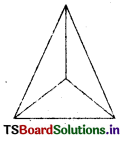
(iv) \(\frac{5}{8}\)
Answer:
\(\frac{5}{8}\)
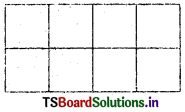
![]()
Question 2.
Write the fraction representing the shaded portion.

Answer:
(i) \(\frac{1}{3}\)
(ii) \(\frac{1}{4}\)
(iii) \(\frac{2}{6}\)
Do This
Question 1.
Write 5 proper fractions and draw them pictorially.
Answer:
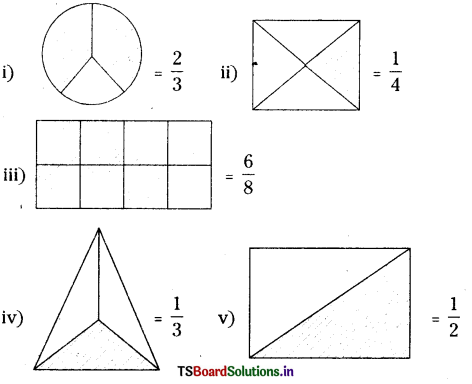
Question 2.
Rani says that shaded portion in the given figure represents \(\frac{1}{4}\). Do you agree with her? Give reason to support your answer.
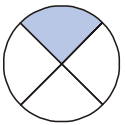
Answer:
Yes. The reason is out of fourportions only one portion is shaded.
Do This
Question 1.
Write improper fractions represented by the following pictures.

Answer:
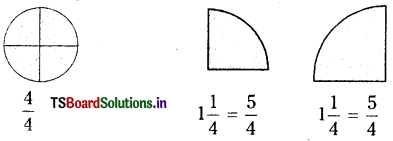
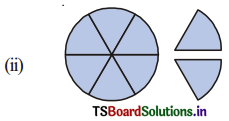
Answer:
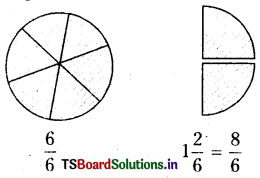
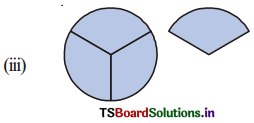
Answer:
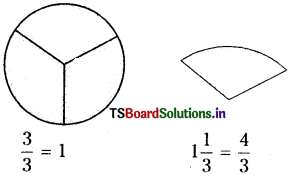
Question 2.
Represent the following fractions pictorially :
\(\frac{7}{4}, \frac{5}{3}, \frac{7}{6}\)
Answer:
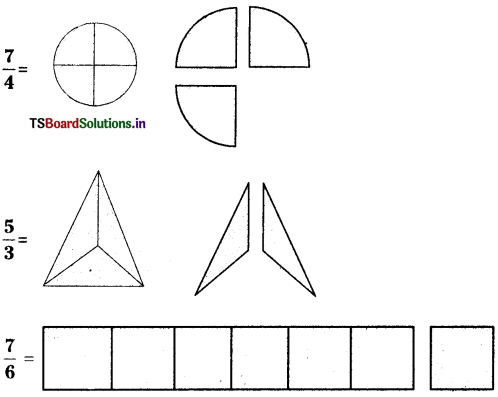
Do This
Question 1.
Write the following as mixed fractions
\(\frac{7}{2}, \frac{8}{5}, \frac{9}{4}, \frac{13}{5}, \frac{17}{3}\)
Answer:

Try These
Question 1.
Write the numerator and denominators of the following fractional numbers:
\(\frac{1}{3}, \frac{2}{5}, \frac{7}{2}, \frac{19}{3}, \frac{7}{29}, \frac{11}{13}, \frac{1}{7}, \frac{8}{3}\)
Answer:
| Fraction | Numerator | Denominator |
| \(\frac{1}{3}\) | 1 | 3 |
| \(\frac{2}{5}\) | 2 | 5 |
| \(\frac{7}{2}\) | 7 | 2 |
| \(\frac{19}{2}\) | 19 | 3 |
| \(\frac{7}{29}\) | 7 | 29 |
| \(\frac{11}{13}\) | 11 | 13 |
| \(\frac{1}{7}\) | 1 | 7 |
| \(\frac{8}{3}\) | 8 | 3 |
Question 2.
Sort the following fractions into the category of proper and improper fractions. Also write improper fraction as mixed fractions:
\(\frac{1}{3}, \frac{2}{5}, \frac{7}{2}, \frac{19}{3}, \frac{7}{29}, \frac{11}{13}, \frac{1}{7}, \frac{8}{3}\)
Answer:
Improper fractions:

Proper fractions:
\(\frac{1}{3}, \frac{2}{7}, \frac{3}{5}, \frac{1}{9}\)
![]()
Do This
Question 1.
Show that following on number lines.
(i) \(\frac{7}{6}\)
Answer:

(ii) \(\frac{5}{2}\)
Answer:

(iii) \(\frac{7}{5}\)
Answer:

(iv) \(\frac{9}{6}\)
Answer:

Question 2.
Consider the following numbers. Which of these would lie on the number line
i) before 1
Answer:
Fractions before 1 are \(\frac{1}{3}, \frac{7}{9}, \frac{6}{11}\)
ii) between 1 and 2
Answer:
Fractions between 1 and 2 are \(\frac{7}{5}, \frac{9}{5}\)
Try These
Question 1.
Write 5 fractional numbers that are in the standard form.
Answer:
Standard form of 5 fractional numbers
= \(\frac{1}{2}, \frac{2}{3}, \frac{4}{5}, \frac{5}{6}, \frac{8}{9}\)
Question 2.
Write 5 fractional numbers that are not in standard form.
Answer:
\(\frac{10}{6}, \frac{144}{100}, \frac{51}{17}, \frac{48}{16}, \frac{36}{44}\)
Question 3.
Convert the following fractions into their standard form.
i) \(\frac{7}{28}\)
ii) \(\frac{15}{90}\)
iii) \(\frac{11}{33}\)
iv) \(\frac{39}{13}\)
Answer:
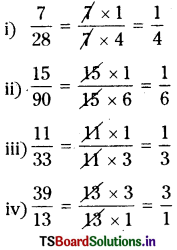
Think, Discuss And Write
Question 1.
Rafi says “there can be no equivalent fractions that are also like fractions”. Do you agree with him ? Explain your answer and justify.
Answer:
Equivalent fractions = \(\frac{1}{2}, \frac{2}{4}, \frac{8}{16}, \frac{32}{64}\)
Like fraction = \(\frac{3}{2}, \frac{5}{2}, \frac{7}{2}, \frac{8}{2}, \frac{9}{2}\)
Equivalent fractions are like fractions also. So, I agree with him.
Do This
Question 1.
Identify the biggest and the smallest in these group of fractional numbers.
(i) \(\frac{1}{7}, \frac{3}{7}, \frac{2}{7}, \frac{5}{7}\)
Answer:
Biggest fraction = \(\frac{5}{7}\)
Smallest fraction = \(\frac{1}{7}\)
(ii) \(\frac{1}{9}, \frac{13}{9}, \frac{11}{9}, \frac{5}{9}\)
Answer:
Biggest fraction = \(\frac{13}{9}\)
Smallest fraction = \(\frac{1}{9}\)
(iii) \(\frac{1}{3}, \frac{5}{3}, \frac{17}{3}, \frac{9}{3}\)
Answer:
Biggest fraction = \(\frac{17}{3}\)
Smallest fraction = \(\frac{1}{3}\)
![]()
Question 2.
Which of these is the smaller fraction ?
(i) \(\frac{2}{5}, \frac{3}{7}\)
Answer:
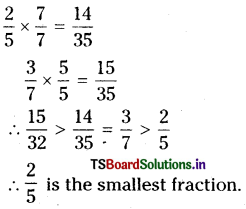
(ii) \(\frac{7}{8}, \frac{5}{4}\)
Answer:
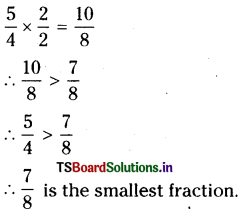
(iii) \(\frac{3}{11}, \frac{1}{2}\)
Answer:
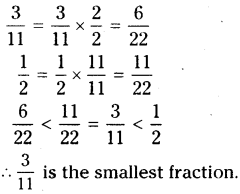
(iv) \(\frac{5}{6}, \frac{2}{3}\)
Answer:
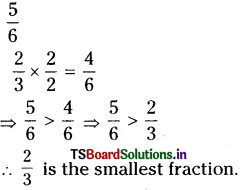
Question 3.
Write the following fractional number in ascending order.
(i) \(\frac{1}{7}, \frac{13}{7}, \frac{11}{7}, \frac{5}{7}, \frac{15}{7}\)
Answer:
Ascending order:
\(\frac{1}{7}<\frac{5}{7}<\frac{11}{7}<\frac{13}{7}<\frac{15}{7}\)
(ii) \(\frac{2}{3}, \frac{5}{6}, \frac{3}{9}, \frac{24}{18}\)
Answer:
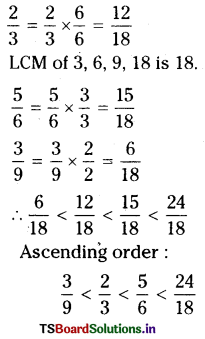
(iii) \(\frac{2}{3}, \frac{1}{2}, \frac{5}{6}, \frac{7}{12}\)
Answer:
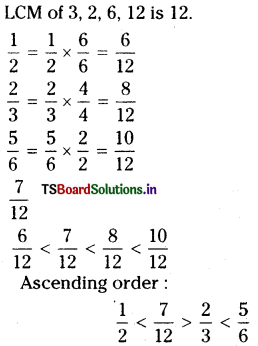
(iv) \(\frac{1}{5}, \frac{1}{2}, \frac{1}{8}, \frac{1}{3}, \frac{1}{12}\)
Answer:
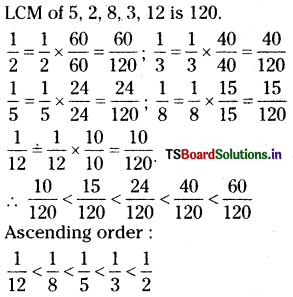
Do this
Question 1.
Write the following in descending order.
i) \(\frac{1}{9}, \frac{13}{9}, \frac{11}{9}, \frac{15}{9}, \frac{3}{9}\)
Answer:

ii) \(\frac{1}{6}, \frac{2}{3}, \frac{3}{9}, \frac{5}{6}\)
Answer:
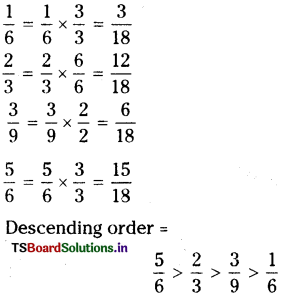
iii) \(\frac{1}{5}, \frac{9}{5}, \frac{3}{5}, \frac{6}{5}\)
Answer:
Descending Order = \(\frac{9}{5}>\frac{6}{5}>\frac{3}{5}>\frac{1}{5}\)
iv) \(\frac{1}{4}, \frac{1}{2}, \frac{1}{8}, \frac{3}{4}\)
Answer:
Descending Order = \(\frac{3}{4}>\frac{1}{2}>\frac{1}{4}>\frac{1}{8}\)
Question 8.
Simplify:
(i) \(\frac{1}{18}+\frac{1}{18}\)
Answer:
\(\frac{1}{18}+\frac{1}{18}=\frac{1+1}{18}=\frac{2}{18}=\frac{1}{9}\)
(ii) \(\frac{8}{15}+\frac{3}{15}\)
Answer:
\(\frac{8}{15}+\frac{3}{15}=\frac{8+3}{15}=\frac{11}{15}\)
(iii) \(\frac{7}{7}-\frac{5}{7}\)
Answer:
\(\frac{7}{7}-\frac{5}{7}=\frac{7-5}{7}=\frac{2}{7}\)
(iv) \(\frac{1}{22}+\frac{21}{22}\)
Answer:
\(\frac{1}{22}+\frac{21}{22}=\frac{1+21}{22}=\frac{22}{22}\) = 1
(v) \(\frac{12}{15}-\frac{7}{15}\)
Answer:
\(\frac{12}{15}-\frac{7}{15}=\frac{12-7}{15}=\frac{5}{15}=\frac{1}{3}\)
(vi) \(\frac{5}{8}+\frac{3}{8}\)
Answer:
\(\frac{5}{8}+\frac{3}{8}=\frac{5+3}{8}=\frac{8}{8}\) = 1
(vii) 1 – \(\frac{2}{3}\left(1=\frac{3}{3}\right)\)
Answer:
1 – \(\frac{5}{8}+\frac{3}{8}=\frac{5+3}{8}=\frac{8}{8}\) [∵ 1 = \(\frac{3}{3}\)]
(viii) \(\frac{1}{4}+\frac{0}{4}\)
Answer:
\(\frac{1}{4}+\frac{0}{4}=\frac{1+0}{4}=\frac{1}{4}\)
(ix) 3 – \(\frac{12}{5}\)
Answer:
3 – \(\frac{12}{5}=\frac{3 \times 5}{1 \times 5}-\frac{12}{5}=\frac{15}{5}-\frac{12}{5}=\frac{15-12}{5}=\frac{3}{5}\)
![]()
Question 9.
Fill in the missing fractions.
i) \(\frac{7}{10}\) – ___ = \(\frac{3}{10}\)
Answer:
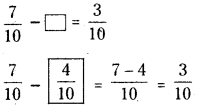
ii) __ – \(\frac{3}{21}=\frac{5}{21}\)
Answer:
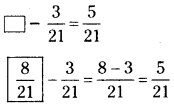
iii) ___ – \(\frac{3}{3}=\frac{3}{6}\)
Answer:
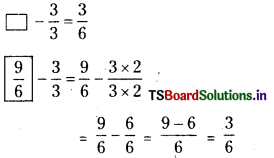
iv) ___ – \(\frac{5}{27}=\frac{12}{27}\)
Answer:
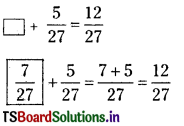
Question 10.
Narendra painted \(\frac{2}{3}\) area of the wall in his room. His brother Ritesh helped and painted \(\frac{1}{3}\) area of the wall. How much did they paint together ?
Answer:
Area of the wall painted by Narendra = \(\frac{2}{3}\)
Area of the wall painted by Ritesh = \(\frac{1}{3}\)
Area of the wall painted by both
Narendra and Ritesh = \(\frac{2}{3}+\frac{1}{3}\)
= \(\frac{2+1}{3}=\frac{3}{3}\) = 1
Narendra and his brother Ritesh painted the complete wall.
Question 11.
Neha was given \(\frac{5}{7}\) of a basket of bananas. What fraction of bananas was left in the basket?
Answer:
The part of a basket of bananas given to Neha = \(\frac{5}{7}\)
The part of bananas left in the basket
= 1 – \(\frac{5}{7}=\frac{1 \times 7}{1 \times 7}-\frac{5}{7}=\frac{7}{7}-\frac{5}{7}=\frac{7-5}{7}=\frac{2}{7}\)
Question 12.
A piece of rod \(\frac{7}{8}\) metre long is broken into two pieces. One piece was \(\frac{1}{4}\) metre long. How long is the other piece?
Answer:
Length of a piece of rod = \(\frac{7}{8}\) metre
Length of one broken piece of rod = \(\frac{1}{4}\) metre.
Length of the other piece = \(\frac{7}{8}-\frac{1}{4}\)
= \(\frac{7}{8}-\frac{1 \times 2}{4 \times 2}=\frac{7}{8}-\frac{2}{8}=\frac{7-2}{8}=\frac{5}{8}\)m
∴ \(\frac{5}{8}\)m long is the other piece.
Question 13.
Renu takes 2\(\frac{1}{5}\) minutes to walk 5 around the school ground. Snigdha takes \(\frac{7}{4}\) minutes to do the same. Who takes less time and by what fraction?
Answer:
Time taken by Renu to walk around the school ground = 2\(\frac{1}{5}\) minutes
= \(\frac{11}{5}\) minutes
Time taken by Snigdha to walk around the school ground = \(\frac{7}{4}\) minutes
To find the person who takes less time to do the same, we write the fractions \(\frac{11}{5}\) and \(\frac{7}{4}\) having the same denominators.
\(\frac{11}{5} \times \frac{4}{4}=\frac{44}{20} ; \frac{7}{4} \times \frac{5}{5}=\frac{35}{20}\)
We know that \(\frac{35}{20}<\frac{44}{20}\)
Therefore, Snigdha takes \(\frac{9}{20}\) minutes less time to walk around the school ground.
(∵ \(\frac{44}{20}-\frac{35}{20}=\frac{44-35}{20}=\frac{9}{20}\))
Try These
Question 1.
(i) Write fractions for the following decimal and also find how many tenth parts are there in each :
0.4, 0.2, 0.8, 1.6, 5.4, 555.3, 0.9
Answer:
0.4 = \(\frac{4}{10}\)
0.2 = \(\frac{2}{10}\)
0.8 = \(\frac{8}{10}\)
4 tenth parts 2 tenth parts 8 tenth parts
1.6 = 1\(\frac{6}{10}\) = 1 + \(\frac{6}{10}\) 6 tenth parts
5.4 = 5\(\frac{4}{10}\) = 5 + \(\frac{4}{10}\) 4 tenth parts
555.3 = 553 + \(\frac{3}{10}\) = 3 tenth parts
0.9 = \(\frac{9}{10}\) = 9 tenth parts
(ii) Complete the following table.

Answer:
| Tens (10) | Ones (1) | One-tenth (1/10) | Decimal number |
| 3 | 5 | 7 | 35.7 |
| 6 | 9 | 4 | 69.4 |
| 7 | 6 | 3 | 76.3 |
(iii) Complete the following table.

Answer:

(iv) Measure the length of these line segments and fill it in the table given below.

Answer:
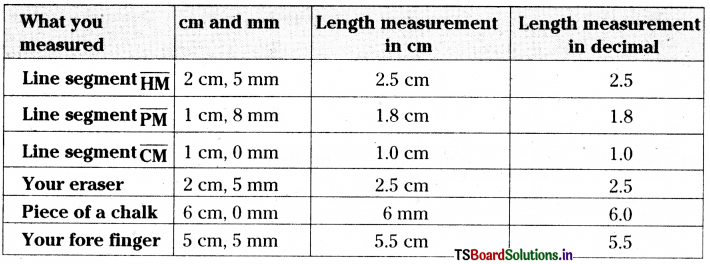
![]()
Do This
Question 1.
Fill in the blanks.
(i) 325 paise = _________ rupees _________ paise = ₹ _________
(ii) 570 paise = _________ rupees _________ paise = ₹ _________
(iii) 2050 paise = _________ rupees _________ paise = ₹ _________
Answer:
(i) 325 paise = 3 rupees 25 paise = ₹ 3.25
(ii) 570 paise = 5 rupees 70 paise = ₹ 5.70
(iii) 2050 paise = 20 rupees 50 paise = ₹ 20.50
Do This
Question 1.
Find: i) 0.39 + 0.26
ii) 0.8 + 0.07
iii) 1.45 + 1.90
iv) 3.44 + 1.58
Answer:
